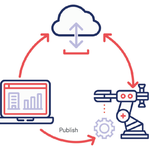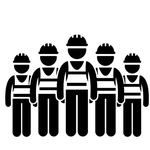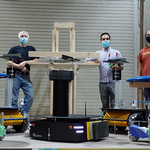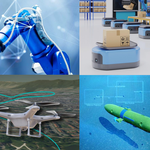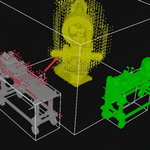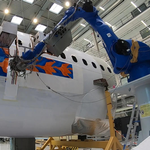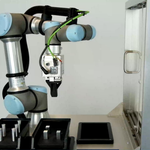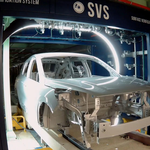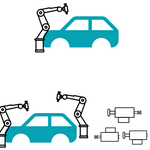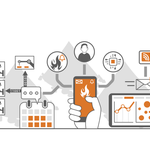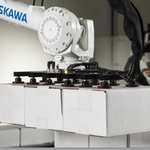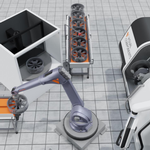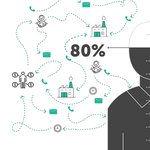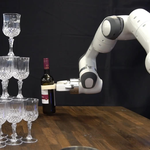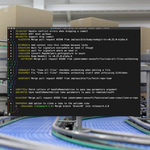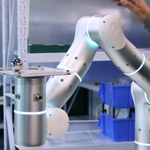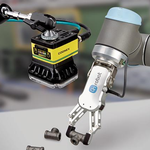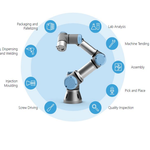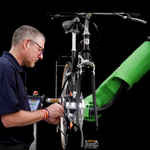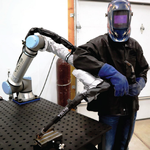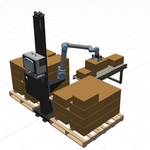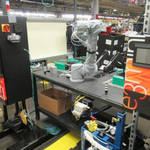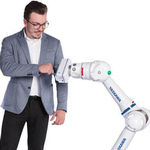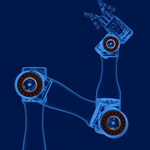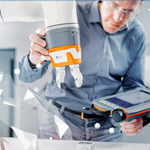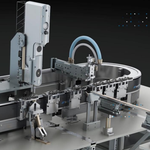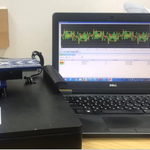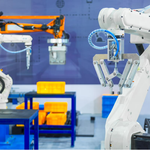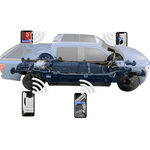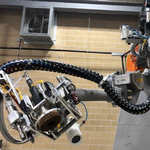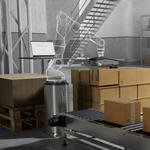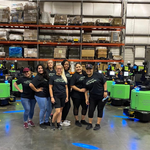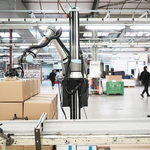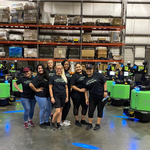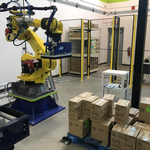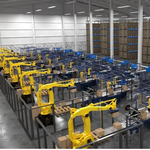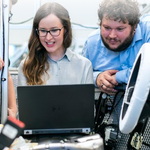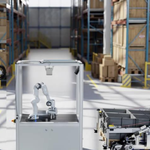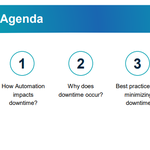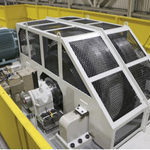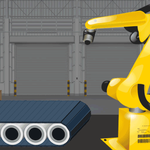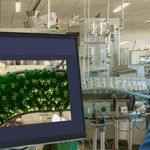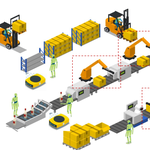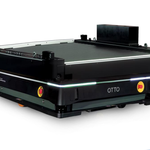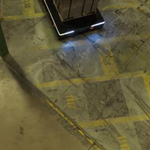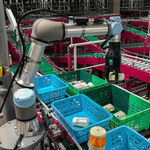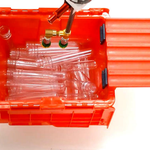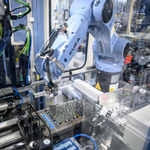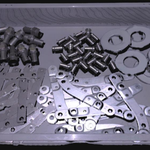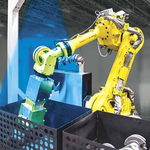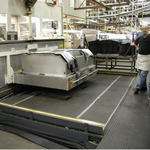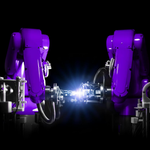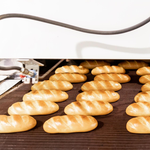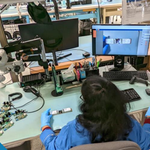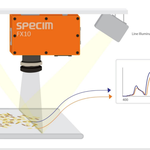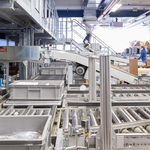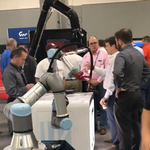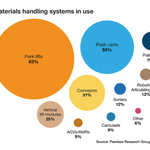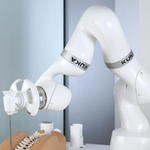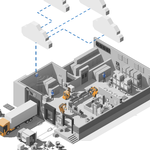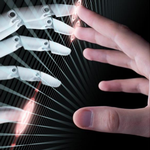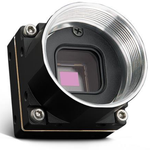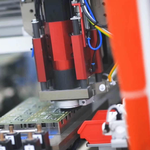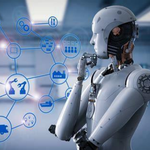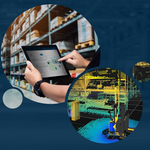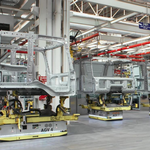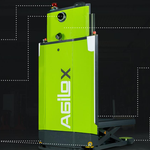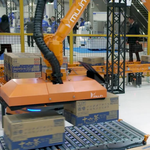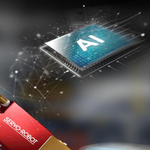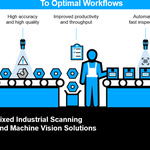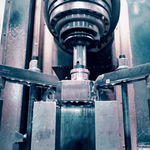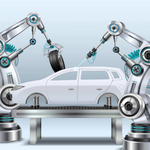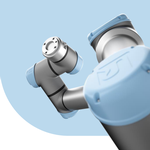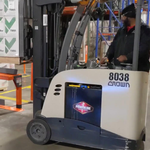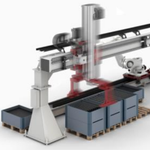Automate 2022
A Low-Code Approach to Industry 4.0
Teresa Martins, Neadvance Machine Vision
Throughout History, humankind has always been dependent on technology. People used the technology they had available to help make their lives easier and, at the same time, try to perfect it and bring it to the next level. This was (and still is) the very basic foundation of every industrial revolution.
- Details
- Download
- Quick View
- Only Available
If Logged In
Evolution of IoT Platforms in Multi-Site Operation
Michael Skurla, Radix IoT
The IoT acronym has given rise to a myriad of products flooding the market. The actual application and advantage of these technologies, however, has been a convoluted topic within all verticals. IoT devices offer abstract promises of data, but the reality is that much of the conversation on IoT has been on the wrong side of the equation.
- Details
- Download
- Quick View
- Only Available
If Logged In
Critical Initiatives in Artificial Intelligence
Michael Skocik, Advanced Robotics for Manufacturing Institute
Satyandra K Gupta, University of Southern California
Kel Guerin, READY Robotics
The Advanced Robotics for Manufacturing (ARM) Institute, the leading national consortium for Robotics and AI, has been working with its 300+ members to identify and prioritize initiatives that make AI/ML more accessible to U.S. Manufacturers.
- Details
- Download
- Quick View
- Only Available
If Logged In
A Multi-Robot System for Manufacturing
Glenn Saunders, Rensselaer MIC
In this session, we will discuss a multi-robot system that was developed in response to the COVID-19 pandemic. The pandemic brought to light a significant number of needs and shortcomings. Early on, one need that became readily apparent was that for Emergency Medical Facilities (EMF) that can be set up quickly to serve a variety of health care services, in a variety of settings such as urban and rural.
- Details
- Download
- Quick View
- Only Available
If Logged In
Designing Intelligent Robots for Air, Ground, Sea
YJ Lim, MathWork
- Details
- Download
- Quick View
- Only Available
If Logged In
Dynamic, Flexible Human-Robot Collaboration
Patrick Toner, Veo Robotics
Human-robot collaboration has become a major focus in manufacturing, with safety standards evolving accordingly. Speed and Separation Monitoring (SSM), as defined by ISO/TS 15066 and ISO 10218, is one of the modes of human-robot collaboration that allows robots to safely work near humans.
- Details
- Download
- Quick View
- Only Available
If Logged In
Robotic Inkjet Printing on 3D Surfaces
Branson Brockschmidt, Southwest Research Institute
Inkjet on 2-D surfaces has been a mature technology for many years, allowing for high-resolution deposition of fluid onto numerous materials, creating a thin but durable coating. Today, this technology is being expanded to 3-D surfaces via robotic systems. The robotic inkjet printing system is comprised of two main components: the printing system and the localization system.
- Details
- Download
- Quick View
- Only Available
If Logged In
Collaborative Robots in Machine Tending
Cory Raizor, SCHUNK
Manufacturing leaders often struggle to take the first step in justifying investments in automation. The first robot is usually the most daunting in terms of unknowns for new users. Small to medium size businesses especially are taking advantage of Cobots and their intuitive nature to benefit from automation. For successful applications, deployments should be fast and straight forward with the ability to adapt to change quickly.
- Details
- Download
- Quick View
- Only Available
If Logged In
AI Systems for Flexible Industrial Automation
Pol Velasco, AUTIS
- Details
- Download
- Quick View
- Only Available
If Logged In
Robotic Paint Repair System
Marcus Pelletier, Robotics and Automation, 3M
- Details
- Download
- Quick View
- Only Available
If Logged In
How Thermal Imaging with IIoT
David Bursell, MoviTHERM
This presentation explains how industrial facilities are finding ways to mitigate and prevent fire damage by implementing infrared camera (IR) technologies and the Industrial Internet of Things (IIoT) for early fire detection.
Fire safety is an area that realizes the benefits of IIoT when combined with IR camera systems.
- Details
- Download
- Quick View
- Only Available
If Logged In
Capital Purchase, Leasing or Robotics-as-a Service
Misa Ilkhechi, Formic Technologies
This presentation will discuss the various options, including the different types of “as-a-service” models that can reduce the sticker shock – and risk - when it comes to automation.
- Details
- Download
- Quick View
- Only Available
If Logged In
Value of 3D Simulation Software in Automation
Graham Wloch, Visual Components North America Inc.
3D Process Simulation software is becoming an integral aspect of automation planning, validation of robot integration, the interaction between human capital and automation, and Digital Twin (or virtual commissioning). We will illustrate the value of simulation software at the beginning stages of automation planning, enabling engineers (process, industrial and manufacturing), and plant costing analysts.
- Details
- Download
- Quick View
- Only Available
If Logged In
De-Risk Your Supply Chain with Smart Manufacturing
Joanne Moretti, Fictiv
Supply chain risks have become overwhelming, with the pandemic and its after effects proving that traditional supply chain strategies and manufacturing ecosystems are ill-equipped and unlikely to survive. That is why 91% of executive respondents to the 2021 State of Manufacturing survey said they have increased investment in digital transformation over the prior year as the lynchpin of a smart manufacturing strategy.
- Details
- Download
- Quick View
- Only Available
If Logged In
Natural Language Commands for Robots
Rogerio Bonatti, Microsoft
Natural language is the most intuitive medium for us to interact with other people when expressing commands and instructions. However, using language is seldom an easy task when humans need to express their intent towards robots, since most of the current human-machine interfaces require rigid templates with a static set of action targets and commands.
- Details
- Download
- Quick View
- Only Available
If Logged In
Modern DevOps Practices with Industrial Automation
Adam Gluck, Copia Automation
DevOps tools have transformed how business software is built, but there were barriers in introducing the same toolsets to industrial automation due to the unique nature of PLC programming. Recently, however, companies are starting to embrace Git-based source control to manage their automation projects. Git-based source control enables greater collaboration between teams, suppliers, and customers.
- Details
- Download
- Quick View
- Only Available
If Logged In
Perception-driven Adaptation
Xiyang Yeh, Flexiv Robotics Inc
To meet the demands for increasingly flexible automation environments in manufacturing, healthcare, and agriculture, robots need to truly perceive the environments and utilize the gathered information to synthesize complex intelligent behaviors and reactively adapt to uncertainties during execution. Over the years, there has been significant development in the fields of robotics and machine learning in this direction.
- Details
- Download
- Quick View
- Only Available
If Logged In
Industrial Metaverse & Mixed Reality
Rajat Gupta, Microsoft
The presentation will focus on two aspects of Mixed Reality in the Enterprise -
1. How Mixed Reality (Augmented Reality and Virtual Reality) is being adopted in the enterprise?
2. How Mixed Reality and Metaverse are different?
- Details
- Download
- Quick View
- Only Available
If Logged In
Human + Machine = Operational Excellence
Prasad Akella, Drishti
Jeffrey Liker, Drishti
From pandemics and global warming to changing market dynamics, myriad challenges mean companies need to be ready to alter production at a moment's notice. Manufacturers agree that humans are more adaptable than automation, but human workers present variability. Manufacturers can gain adaptability while error-proofing their workers using AI and video analytics.
- Details
- Download
- Quick View
- Only Available
If Logged In
Extending Cobot Applications
Rick Conneely, Eaton Tripp Lite
Collaborative robots are being applied in exciting new applications everyday given their ease of use and ability to connect to any 120V power source. Much of the focus today is on the end effectors and their ability to complement the collaborative work with employees. The power requirements to run cobots are typically considered a given and often pushed to the person deploying or running the cobot.
- Details
- Download
- Quick View
- Only Available
If Logged In
Top 10 Questions to Ask a Cobot Supplier
Sumer Petrous, Universal Robots
Collaborative robots make up the fastest-growing segment of the robotics industry, thanks to their affordability and fast deployment compared to traditional robots. But not all manufacturing processes have the same outlook for cobot automation, and not all cobot suppliers are created equal. Johnny Leak, Channel Development Manager at Universal Robots, will explore the unique technologies in collaborative robots that are openin
- Details
- Download
- Quick View
- Only Available
If Logged In
Making Collaborative Applications Collaborative
Greg Buell, FANUC America
Whether working hand in hand with your robot, or rarely interacting with it, understanding what actually makes a collaborative application collaborative is important and will go a long way to choosing the right solution to your automation challenge. This presentation will discuss 2 distinctly different collaborative applications and what it is that really makes them collaborative.
- Details
- Download
- Quick View
- Only Available
If Logged In
Cobots & Welding
Stu Shepherd, Universal Robots
Cobot welding has seen an explosion in interest over the last few years, thanks to the improved productivity they offer metal fab businesses and the improved work they offer skilled welders. Join Stu Shepherd, Vertical Director at Universal Robots, to discover how cobot users are attracting and retaining talent, securing more work, and expanding productivity with their collaborative welding systems.
- Details
- Download
- Quick View
- Only Available
If Logged In
Save Time and Money with Cobot Deployment
Étienne Samson, Robotiq
- Details
- Download
- Quick View
- Only Available
If Logged In
Automotive Glass Priming with Collaborative Robots
Johnny Rodriguez, Pilz Automation Safety
Jordan Punch, Pilz Automation Safety
Automotive glass is secured to the car body using adhesive to secure and seal the glass while adding to the structural strength of the vehicle. The glass must be prepared by a two-step process of cleaning and priming the glass.
- Details
- Download
- Quick View
- Only Available
If Logged In
Evolving Applications for Collaborative Robots
Chris Caldwell, Yaskawa America, Inc.
As robots are increasingly deployed to supplement our workforce in new applications, collaborative robots are becoming the gateway to automation. One study on the advance of automation found “over 88% of organizations believe that automation will accelerate human achievement and be most effective when it complements humans” (UiPath et al, 2019).
- Details
- Download
- Quick View
- Only Available
If Logged In
Advances in Motors
Todd Brewster, Kollmorgen
The drive toward higher efficiency in manufacturing has been focused over the years on higher power motors applications used in heavy industries. The design considerations for permanent magnet (PM) motors used in robotics applications offer considerable differences compared to constant speed efficiency gains.
- Details
- Download
- Quick View
- Only Available
If Logged In
Robot Interoperability in the Industry 5.0 World
Pat Duda, KUKA Robotics
The advent of machine learning, AI, and Big Data promises to assist manufacturing workers to achieve new levels of efficiency. Applying these technologies to your processes requires reaching beyond the capabilities of software and hardware of robots and their controllers. Taking advantage of the best technologies often requires many of the capabilities to be offloaded to specialized hardware or the cloud.
- Details
- Download
- Quick View
- Only Available
If Logged In
Designing Your Automation with Smart Conveyance
Ben Hope, SuperTrak CONVEYANCE
- Details
- Download
- Quick View
- Only Available
If Logged In
Improving High-Precision Motion System Performance
Jason Goerges, ACS Motion Control
- Details
- Download
- Quick View
- Only Available
If Logged In
Advanced EOAT Applications and Tool Changers
Bethany Colbry, ATI Industrial Automation
The most common application for the robotic tool changer has historically been material handling. As robots are used for more applications we see an increase in complexity of the end-of-arm tooling (EOAT). Applications featuring multiple joining tools, vision, and advanced motion control are becoming more common.
- Details
- Download
- Quick View
- Only Available
If Logged In
Mobile Artificial Intelligence Vision System
Walter LaPlante, Ford Motor Company
Mobile Artificial Intelligence Vision System (MAIVS) uses computer vision and machine learning for real-time defect detection, where it can quickly notify operators that defects are apparent and action is needed to ensure zero defect forward. The system consists of an iOS edge device running the IBM Maximo Visual Inspection Mobile application.
- Details
- Download
- Quick View
- Only Available
If Logged In
Deploying Open-Source on the Shop Floor
Matthew Robinson, Southwest Research Institute
The ROS-Industrial open source project has been around now for nearly 10 years. There have now been extensive examples of ROS and other open source tools running in factories.
- Details
- Download
- Quick View
- Only Available
If Logged In
Collaborative Palletizing Applications
Kristian Hulgard, OnRobot
- Details
- Download
- Quick View
- Only Available
If Logged In
From No-Bot to Robot
Jeff Huerta, Vecna Robotics
- Details
- Download
- Quick View
- Only Available
If Logged In
What’s The True Cost of Robotic Palletizing?
Étienne Samson, Robotiq
- Details
- Download
- Quick View
- Only Available
If Logged In
Human-Robot Collaboration
Lior Elazary, inVia Robotics
- Details
- Download
- Quick View
- Only Available
If Logged In
Workforce Development and Accelerated Automation
Craig Salvalaggio, Dematic
Technological advances in industrial automation mean robots can take on dull, dirty, and dangerous tasks - elevating human workers to higher-value positions. But what are companies doing to get ready? How can companies skill, train and retain workers in this new paradigm of warehouse automation?
- Details
- Download
- Quick View
- Only Available
If Logged In
Getting Started with Robots as a Service (RaaS)
Mandy Dwight, RIOS Corporation
Clinton Smith, RIOS Corporation
A new breed of quick deploying, cost efficient robotic workcells are available to automate dexterous and labor-intensive tasks such as end of line packaging, order fulfillment, food handling, assembly, machine tending, or inspection in a “pay as you go'' Robotics as a Service (RaaS) pricing model.
- Details
- Download
- Quick View
- Only Available
If Logged In
Manufacturing Consideration in Today's New Normal
Scott Marsic, Epson Robots
We will explore the "how" and "why" of automation from the vantage point of today's decision makers as they evaluate robotics and manufacturing within their business. Topics will include changes to customer pain points, onshoring & near-shoring impacts, market trends and top insights for project success.
- Details
- Download
- Quick View
- Only Available
If Logged In
How AI is Transforming Manufacturing and Logistics
Amit Goel, NVIDIA
Everything will become smarter in the factory floor, from machines to handlers and from ground vehicles to conveyor belts. Edge AI and Robotics are playing a vital role to transform industrial automation processes to fully autonomous systems in manufacturing and logistics. Adding intelligence at the edge enables machines in production to sense the environment, act autonomously and make critical decisions.
- Details
- Download
- Quick View
- Only Available
If Logged In
Ethics and Bias in AI - Understanding the Risks
Tom Knauer, Balluff
- Details
- Download
- Quick View
- Only Available
If Logged In
Condition Monitoring And Predictive Maintenance
Tom Knauer, Balluff
- Details
- Download
- Quick View
- Only Available
If Logged In
Using Simulation to Maximize Efficiency for Robots
Anthony Navarro, Unity
Simulation is a powerful tool in robotics system development allowing you to design a system that performs in diverse environments, adapts to changes, and operates safely, saving both time and money. This talk will cover the advantages of using simulation in robotic systems development and deployment and explore strategies used in simulation that enable robust and efficient systems.
- Details
- Download
- Quick View
- Only Available
If Logged In
Scaling Your Logistics Robotic Solution
Matt Wicks, Celestica
There is no shortage of excitement in the logistics space today – pandemic-driven e-commerce and consumer expectations for same-day delivery, increased by online and curbside pick-up service options as well as the rise of urbanization, and escalating labor challenges. It’s no wonder companies are turning to robotics to help solve these challenges.
- Details
- Download
- Quick View
- Only Available
If Logged In
Simulated Environments for the Future of Autonomy
Max Versace, Neurala
- Details
- Download
- Quick View
- Only Available
If Logged In
Cybersecurity: Secure Digital Transformation
Leah Dodson, Jeremy Dodson, and Jay Korpi (NextLink Labs)
Today’s cybersecurity landscape has organizations across the globe on edge. The rise of organized cybercrime has provided attackers more resources than ever before, resulting in critical vulnerabilities being identified and exploited almost daily. How can your organization support modern growth and digital transformation while protecting the security and safety of your assets?
- Details
- Download
- Quick View
- Only Available
If Logged In
AI in Manufacturing: The Truth and the Myth
Juan Aparicio, Rapid Robotics
There is significant hype around AI and its potential applications in manufacturing. In this session, join A3's AI Technology Strategy Board member - Juan Aparicio - in discovering the common misconceptions and myths of AI in manufacturing.
- Details
- Download
- Quick View
- Only Available
If Logged In
Mobility & Manipulation in the Warehouse
Nicolas De Keijser, Boston Dynamics
Brian Gaunt, DHL Supply Chain
Truly flexible solutions for warehouse automation require advanced manipulation and mobility. This session will focus on how crucial robotic manipulation is to the careful handling of carton boxes and cases, and how robotic movement untethered by power lines or bolted-down infrastructure can make way for additional automated tasks in the warehouse.
- Details
- Download
- Quick View
- Only Available
If Logged In
Intro to Mobile Robot Risk Assessment
Bob Bollinger, Dynamic Horizons Automation Solutions
- Details
- Download
- Quick View
- Only Available
If Logged In
Progress Toward Multi-application Indoor AMRs
Pablo Molina, Avidbots
Most indoor autonomous mobile robots (AMRs) on the market today are specialized, often addressing a single application/service and market segment. Today’s robots solve for a limited use case, deliver rather narrow benefits, and, as a result, offer little potential to grow given the limited market that they solve.
- Details
- Download
- Quick View
- Only Available
If Logged In
Integrators Insights on AMR Integration
Terry Meister, AMT
Autonomous Mobile Robots are being used anywhere from pallet relocation to implementing a robot on top of the AMR for use in production facilities. Alone or with an attached tool, AMRs are assisting plants worldwide. You will even see automated forklifts that fall under the AMR umbrella.
- Details
- Download
- Quick View
- Only Available
If Logged In
Using Fleet Analytics for Continuous Optimization
Adrian Ennis, OTTO Motors
Material handling is the lifeblood of modern manufacturing and warehousing. Proper flow of material into, out of, and within facilities is what makes businesses successful. Automating material handling with AMRs improves reliability to provide business continuity and increases throughput to maximize profit.
- Details
- Download
- Quick View
- Only Available
If Logged In
AMRs and Order Picking Automation
Yaqing Sun, Omron Automation Americas
In this presentation, we will share a few specific case studies of using AMRs for order picking assistance in conventional warehouses.
- Details
- Download
- Quick View
- Only Available
If Logged In
Reducing Risks Associated with Whole Body Access
Aaron Woytcke, SICK Inc.
The concept of “whole body access” – as well as the associated r+AA39isks to employees – is by no means new to industry; in fact, it is an enduring risk prevalent in many automated systems in factory and logistics automation.
- Details
- Download
- Quick View
- Only Available
If Logged In
Picking Transparent Objects from a Random Bin
Sina Afrooze, Apera AI
This course covers 2D & 3D machine vision camera calibration for machine guidance including for industrial robots together with basic information on the types of industrial robots in use today.
- Details
- Download
- Quick View
- Only Available
If Logged In
AI Systems for Flexible Industrial Automation
Michael Suppa, Roboception GmbH
This course covers 2D & 3D machine vision camera calibration for machine guidance including for industrial robots together with basic information on the types of industrial robots in use today.
- Details
- Download
- Quick View
- Only Available
If Logged In
Flexible Robot Grasping of Unknown Objects
Jose Luis Susa Rincon, Siemens
- Details
- Download
- Quick View
- Only Available
If Logged In
The Main Source of Error in Vision-Guided Robots
Jesse Masters, Zivid
This course covers 2D & 3D machine vision camera calibration for machine guidance including for industrial robots together with basic information on the types of industrial robots in use today.
- Details
- Download
- Quick View
- Only Available
If Logged In
Vision Guided Robotic Bin Picking
David Bruce, FANUC America Corporation
This course covers 2D & 3D machine vision camera calibration for machine guidance including for industrial robots together with basic information on the types of industrial robots in use today.
- Details
- Download
- Quick View
- Only Available
If Logged In
Introduction to Robot Risk Assessment
Jeff Fryman, Association for Advancing Automation
- Details
- Download
- Quick View
- Only Available
If Logged In
Automating Visual Inspection
Caleb Davis, UnitX
Of all the places where artificial intelligence is making a difference in manufacturing, vision inspection use-cases may be the most significant and most mature. Join these industry experts as they discuss how AI-based vision applications are leading higher quality, enhanced processes and greater flexibility.
- Details
- Download
- Quick View
- Only Available
If Logged In
Vision AI Improving Factory Floor Inspection
Steve Walsh, Neurala
Of all the places where artificial intelligence is making a difference in manufacturing, vision inspection use-cases may be the most significant and most mature. Join these industry experts as they discuss how AI-based vision applications are leading higher quality, enhanced processes and greater flexibility.
- Details
- Download
- Quick View
- Only Available
If Logged In
Event-based Vision and Machine Vision Applications
Davide Migliore, Prophesee
Of all the places where artificial intelligence is making a difference in manufacturing, vision inspection use-cases may be the most significant and most mature. Join these industry experts as they discuss how AI-based vision applications are leading higher quality, enhanced processes and greater flexibility.
- Details
- Download
- Quick View
- Only Available
If Logged In
Solving Visual Inspection Errors with AI
Ed Goffin, Pleora Technologies
Of all the places where artificial intelligence is making a difference in manufacturing, vision inspection use-cases may be the most significant and most mature. Join these industry experts as they discuss how AI-based vision applications are leading higher quality, enhanced processes and greater flexibility.
- Details
- Download
- Quick View
- Only Available
If Logged In
Hyperspectral Vision Applications
Mathieu Marmion, SPECIM
Hyperspectral imaging has been available for decades, but faster and cheaper available sensors make the method now attractive for the industry. In fact, hyperspectral imaging combines imaging and spectroscopy, offering new insights over traditional systems, mostly based on Xrays, RGB or multispectral sensors. This presentation will focus on the advantages the hyperspectral technology with success integration success stories.
- Details
- Download
- Quick View
- Only Available
If Logged In
Crash Course in Automation Sensors & Cables
Will Healy III, Balluff Worldwide
Never implemented automation before? New grad, new job, new expectations? No technical experience? No Problem! In this crash course, we will cover how a machine works and the basics of automation electrical systems. Plus, we will review a few of the most common sensor technologies.
- Details
- Download
- Quick View
- Only Available
If Logged In
Leveraging Multiple EOAT Handling Technologies
Tom Reek, SCHUNK
Engineers and production managers are looking to maximize their investments in automation, being able to deploy and redeploy robots for multiple and changing tasks. Even within similar manufacturing processes, workpieces may continually change in size, shape, weight, and materials creating the need for adaptable robot EOATs.
- Details
- Download
- Quick View
- Only Available
If Logged In
The Great Resignation and Automation
Lou Finazzo, FANUC America
Robots and automation are easier to use than ever before - they are more flexible, reliable and affordable. Those benefits alone are all reasons to do a 360 on traditional production methods, but add the ‘Great Resignation’ to the mix and you’re looking at multiple challenges.
- Details
- Download
- Quick View
- Only Available
If Logged In
Robots-as-a-Service (RaaS)
Fouad Khalil, Locus Robotics
Safely deploying robotics in the warehouse requires overcoming numerous complex technical and operational challenges, including security and compliance. Like other Internet of Things (IoT) devices, robotics can be vulnerable to a variety of cyberattacks, exploiting physical and digital interfaces.
- Details
- Download
- Quick View
- Only Available
If Logged In
Robotics and AI Governance
Dominik Boesl, Micropsi Industries
Trust is the key to safe, successful automation. But how do we build trust when AI and machine learning systems have the ability to adapt and evolve. Join these industry experts in a discussion on trust and explainability in autonomous systems.
- Details
- Download
- Quick View
- Only Available
If Logged In
Ethics and Bias in AI - Understanding the Risks
Corey Ryan, KUKA
Trust is the key to safe, successful automation. But how do we build trust when AI and machine learning systems have the ability to adapt and evolve. Join these industry experts in a discussion on trust and explainability in autonomous systems.
- Details
- Download
- Quick View
- Only Available
If Logged In
The Key to Building Trust in Autonomous Systems
Nathan Bivens, FORT Robotics
Trust is the key to safe, successful automation. But how do we build trust when AI and machine learning systems have the ability to adapt and evolve. Join these industry experts in a discussion on trust and explainability in autonomous systems.
- Details
- Download
- Quick View
- Only Available
If Logged In
Building an AI or Smart Manufacturing Strategy
Christine Boles, Intel
Manufacturers are always seeking new ways to optimize their operations and reduce costs. Now, as sustainability continues to become top of mind for many organizations, it can seem like a competing objective. However, it’s possible to achieve both business and sustainability goals by adopting a data-driven strategy to fuel AI and machine learning applications. Today, most factories still only leverage a fraction of their operational da
- Details
- Download
- Quick View
- Only Available
If Logged In
Intent Prediction in Human Robot Interactions
Paul Santi, FANUC America
Sara Masoud, Wayne State University
Intent prediction, also known as intention recognition or detection, is one of the core components of social cognition. From the age of 18 months, human beings have been shown to be able to extrapolate intentions from observed actions. A key technical component for intent prediction from observed bodily movements is the discovery and utilization of the spatiotemporal patterns behind those movements.
- Details
- Download
- Quick View
- Only Available
If Logged In
Deep Learning and Vision AI with Manufacturing
Max Versace, Neurala
The manufacturing world is facing old and new challenges. Companies are facing irregular patterns in consumer demands and increased pressures on machine utilization, production efficiencies, and quality control – and they need to address all of this with fewer people on the factory floor.
- Details
- Download
- Quick View
- Only Available
If Logged In
Industrial Edge - Make the Most of Your Data
Chris Liu, Siemens
The volume of data in industry continues to grow. How can you acquire knowledge from this vast amount of information so you can make the right decisions and take fast action? Industrial Edge is an integral part ofthe Digital Enterprise portfolio that serves to transform endless volumes of data into limitless opportunities. Join us for more information including an overview of architecture, benefits,use cases, and where to start.
- Details
- Download
- Quick View
- Only Available
If Logged In
Where Should You Begin With Industry 4.0 and IIoT
Christina Pierce, Panasonic IIoT Solutions
Though the manufacturing industry generally accepts the need to automate, the barrier to entry can cause hesitation. However, there are clear baby steps manufacturers can take to begin their journey to automation. In this session, we’ll look at several initial steps in the manufacturing process that can be improved with IIoT, including paper-based operations, improving material flow, and locating inventory.
- Details
- Download
- Quick View
- Only Available
If Logged In
The Multi-Robot Warehouse of the Future
Florian Pestoni, InOrbit
While robot deployments within warehouses and fulfillment centers tend to focus on a single robot platform (either mobile or fixed robot arm), the day is coming when multiple robot types will be traversing the floor. Cleaning robots, inventory robots, and drones will soon be working alongside delivery robots and autonomous forklifts to get their tasks done.
- Details
- Download
- Quick View
- Only Available
If Logged In
AMRs and the Human Workforce
Todd Graves, Seegrid
Manufacturing, e-commerce, and logistics facilities are struggling to fill surging order volumes on time and accurately with today’s evolving demands, especially amid an ongoing labor shortage. To solve for today’s biggest challenges, more companies are turning to automation solutions to increase reliability, safety, and productivity for the competitive advantage. But what does this mean for the future of the human workforce?
- Details
- Download
- Quick View
- Only Available
If Logged In
Using Robotics Business Intelligence to Optimize P
Jason Walker, Locus Robotics
Business intelligence is transforming all sectors of the economy, including t warehousing and manufacturing. As robotic automation becomes an integral part of these operations, effective use of the data these solutions generate gives critical visibility into what’s going on inside your facility, and provides a valuable and actionable resource for planning, operations, labor management and more.
- Details
- Download
- Quick View
- Only Available
If Logged In
Mobile Robot Application Considerations
Denise Ebenhoech, KUKA Robotics
In recent years, advances in technology have broken traditional AGVs from their tethered paths and given way to a new generation of sophisticated mobile platforms that can independently support more intricate processes and overcome past time and space limitations.
- Details
- Download
- Quick View
- Only Available
If Logged In
Top 5 Trends in the AMR Market
Søren E. Nielsen, Mobile Industrial Robots A/S
Søren E. Nielsen, the president of Mobile Industrial Robots (MiR), the leading manufacturer of collaborative and autonomous mobile robots, discusses the current forces driving the AMR market.
- Details
- Download
- Quick View
- Only Available
If Logged In
AI-Driven AI Fleet Management
Andreas Boedenauer, AGILOX North America, Inc.
Business success depends on a lot of factors: Innovative products, outstanding services, financial prudence, manufacturing excellence. To excel, all parts of the organization work together in sync. Consequently, mitigating the risk for any disruption of this collaboration is a key objective of management. In a worst case scenario, a Single Point Of Failure can bring the entire operation to a costly halt.
- Details
- Download
- Quick View
- Only Available
If Logged In
Intelligent Robotics for the Modern Warehouse
Brandon Coats, Mujin
Logistics facilities have a need for more intelligent robotic systems, which are value-adding, production-ready, and reduce the cost of the overall material handling solution. The next generation of robots should be capable of perception, awareness, and autonomous decision-making, which will allow companies to deploy more robotic systems into production and into new, more advanced applications.
- Details
- Download
- Quick View
- Only Available
If Logged In
Automate Your Visual Weld Inspection
Jeffrey Noruk, Servo Robot Corp
- Details
- Download
- Quick View
- Only Available
If Logged In
Ensuring Success with EV Powertrain Deployments
Vikram Mankar, GE Digital
GE Digital Smart Factory MES is designed for rapid multi-plant deployments. Build first template site, export the configuration, import into subsequent sites changing site relevant master data). The Smart Factory MES user interface has a mobile first HTML5 UI and can be Dockerized to ensure 100% uptime.
- Details
- Download
- Quick View
- Only Available
If Logged In
Understanding Robot Accuracy
Houssaine Waled, KUKA Robotics
Many robotic applications require high positional and path accuracy. These include machining, non-destructive testing, and any application that uses offline programming. Robots have come a long way in terms of static and dynamic performances. However, failing to understand robot accuracy and the factors that affect it can lead to undesirable outcomes. Many users have high expectations when it comes to robot accuracy.
- Details
- Download
- Quick View
- Only Available
If Logged In
Maximize Technology and Investment
Jim Witherspoon, Zebra Technologies
Artificial intelligence and deep learning solutions are the next generation of vision inspection. From a barcode reader to a deep learning solution, this presentation will share how companies are solving problems today and future-proofing and enhancing their solutions for tomorrow.
- Details
- Download
- Quick View
- Only Available
If Logged In
3D Printed End-of-Arm Tools
Liz Stortstrom, HP 3D Printing
The use of additive manufacturing in the robotics and industrial automation industry is becoming more prevalent every day. Material handling solutions are highly customized to the end-user, and additive manufacturing can complement and address many of the shortcomings of traditional manufacturing methods like machining and injection molding.
- Details
- Download
- Quick View
- Only Available
If Logged In
Vision Automation Headwinds and Tailwinds
Dave Kelly, Perceptron
The adoption of vision-enabled automation within the manufacturing sector has been accelerating, driven by widening demand and new 3D vision technology. The demands for quality, throughput, speed, agility, lower costs, and recently labor shortages are being met by ever more automation, particularly vision-enabled automation.
- Details
- Download
- Quick View
- Only Available
If Logged In
Connecting Automation to Business Challenges
Bryan Bird, Universal Robots
Bryan Bird, Regional President of US/Canada for Universal Robots, is building the case for manufacturers getting ahead of their most pressing business challenges with collaborative robots. This presentation will provide an overview of common manufacturing challenges and demonstrate how collaborative automation systems bring performance improvements to directly address these challenges.
- Details
- Download
- Quick View
- Only Available
If Logged In
Lessons from the Field
Jim Lawton, Zebra Technologies
Is there a way to ensure that investment in automation can deliver all that is expected? For many companies, betting on automation is not a decision made lightly. Of course, there’s the pure cost of the solution, but all too often there are unknowns that quickly add up – and eat up any potential ROI. Things like the need to reconfigure space or workflows. Often, there is intensive training and additional equipment.
- Details
- Download
- Quick View
- Only Available
If Logged In
Getting Started in Robotics: Pt 2
Bob Bollinger, Dynamic Horizons Automation Solutions
Industrial Robots are the heart of Lean Manufacturing and are vital to the current vibrant manufacturing economy in North America. The “Getting Started with Robotics” presentation is an introduction to the Industrial Robotics or Flexible Automation Industry.
- Details
- Download
- Quick View
- Only Available
If Logged In
Getting Started in Robotics: Pt 1
Bob Rochelle, Güdel
Industrial Robots are the heart of Lean Manufacturing and are vital to the current vibrant manufacturing economy in North America. The “Getting Started with Robotics” presentation is an introduction to the Industrial Robotics or Flexible Automation Industry.
- Details
- Download
- Quick View
- Only Available
If Logged In
*Assets marked for members only are subject to membership level eligibility.
- Platinum
- Gold
- Silver
- Bronze
- Non-Member


